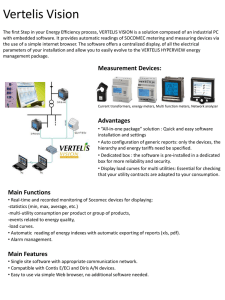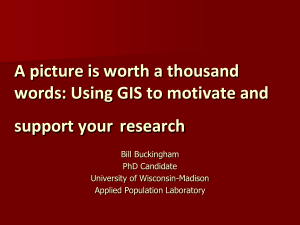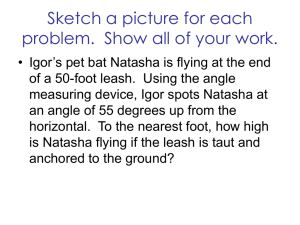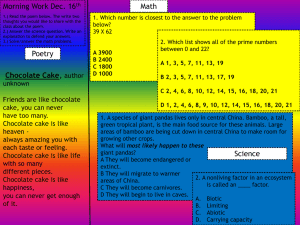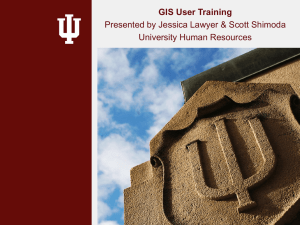Urban Development Plan
advertisement
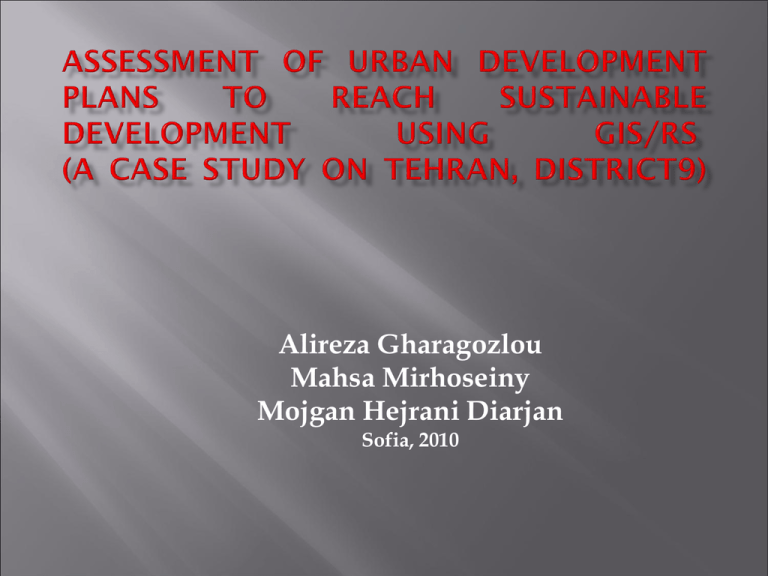
Alireza Gharagozlou Mahsa Mirhoseiny Mojgan Hejrani Diarjan Sofia, 2010 Recognizing The Existing Potentials of Iran in Identification of Natural Resources with a Land Use Planning Approach, Urban Development Model Using Environmental Modeling and GIS/RS Alireza Gharagozlou, National Cartographic Center of Iran Role of GIS and Remote Sensing in Land Use Planning and Environmental Impact Assessment Conceptual Model of GIS/RS and EIA and Land Use Planning Presenting Mathematical Model for Urban Development Plans for Tehran by using Environmental Modeling and GIS/RS Methods of Resource Identification Data Gathering and Monitoring by Remote Sensing and Analysis by GIS What is Proper? 1. Statistics, Sampling 2. Arial Photography 3.Remote Sensing 4.GIS A. Resources Identification Sustainable Natural Resources of the Region Related to the Objective Application of GIS and Remote Sensing B. Analysis and Organizing the Resources Production of Necessary Maps for Assessment by Using GIS Application of GIS in Assessment C. Assessment of Ecological and Economic Potentials Comparing the Present Status with the Models Determination of Potentials for Development D. Strategic Planning National and Regional Levels Spatial Analysis by Using GIS and Considering the Options E. Determination of the Type of Application Decision Making Environmental Impact Assessment F. Compilation of the Project Take Actions GIS and Remote Sensing for Monitoring G. Implementation Users and Organizations Y1 (1984) = S(1,2,3) + H(1,2,3,4) + A(1,3,4,5) + QA(2,3,4,5) + MA(3,4) + WS(1,2,3,4,5) + SO(1,2,3,4,5,6,7,8,9) + SW(1,2,3,4) + NI(2,3,4,5) Y2 (1994) = S(1,2,3,4,5) + H(1,2,3,4,5,6,) + A(1,2,3,4,5) + HW(1,2) + SO(1,2,3,4,5,6,7,8,9,10,11) + WS(1,2,3,4,5,6) + QA(1,2,3,4,5) + NI(1) + MA(2,3,4) + HP(1,2,3,4) Y3 (1998) = S(1,2,3,4,5) + H(1,2,3,4,5,6) + A(1,2,3,4,5) + WS(1,2,3,4,5) + SO(1,2,3,4,5,6,7,8,9,10,11) if S(5,6) + NI(2,3,4,5) + QA(2,3,4,5) Y4 (2001) = SW(3,4) + HP(3,4) + QA(2,3,4,5) + S(1,2,3,4) + H(1,2,3) + WS(1,2,3,4,5) S is slope, H is height or altitude A is aspect, QA is fault line MA is distance from ravine areas WS is wind speed, SO is soil components SW is distance from subterranean water resources NI is distance from industrial sites HW is green buffer around highways, HP is historical landmark "Slope" (S) includes six classes: 0 to 2% (class 1), 2 to 5% (class 2), 5 to 8% (class 3), 8 to 12% (class 4), 12 to 15% (class 5), and more than 15% (class 6). "Height" (H) includes six altitude classes: less than 1000 meters (class 1), 1000-1200 meters (class 2), 1200-1400 meters (class 3), 1400-1600 meters (class 4), 1600-1800 meters (class 5), and more than 1800 meters (class 6). "Aspect" (A) refers to geographical direction and includes five classes (northern, southern, eastern, western, or no direction). "Distance from ravine areas" (MA) includes four classes: less than 50 meters (class 1), 50-300 meters (class 2), 300-500 meters (class 3), and more than 500 meters (class 4). "Subterranean water resources" (SW) divides resources into four classes, based on distance to the water resource: less than 100 meters (class 1), 100-500 meters (class 2), 500-1000 meters (class 3), and more than one kilometer (class 4). "Distance from industrial sites" (NI) includes three classes: less than 5 kilometers (class 1), 5-10 kilometers (class 2), and 10-20 kilometers (class 3). "Green buffer around highways" (HW) should be considered in all environmental assessments and development plans. These buffers should be planted with evergreen trees appropriate to the region. Green buffer areas are divided into three classes: less than 10 meters (class 1), 10-100 meters (class 2), and more than 100 meters (class 3). "Historical landmark" (HP) divides historical places into four classes, based on how far away they are located: less than 5 kilometers (class 1), 5-10 kilometers (class 2), 10-20 kilometers (class 3), and more than 20 kilometers (class 4). Other categories, such as soil components (SO) and wind speed (WS), also include multiple classes. Urban Development Plan Determining land use changes by using Arial photos and satellite images to environmental assessment and evaluation of development plans Through the comparison of urban applications of territories, aerial photos (1955 &1992 & 2005) and satellite images, TM (1992), ETM+ (2008), analysis of city standards regarding their national dimensions by using GIS, most of the problems of the area were known Boundaries of urban applications in Tehran's District 9, including schools, healthcare centers (hospitals and clinics), factories and industrial and workshop centers based on standards were determined and set by using GIS analysis and in keeping with the existing related standards Green Areas in 2002 Aerial photos taken from the District in 1955 shows that the area of open or non-constructed lands has been 156661.30 square meters whereas aerial photos and satellite images taken from the same District in 2002, shows an equivalent of 2682.10 square meters It can be concluded then that the scales of construction works have increased by 58 times during the 47 year period of time A comparison of green area in the two intervals of 1955 and 2002 helps prove that greeneries had occupied an area of 23906.90 square meters in 1955 whereas the figure in 2002 has decrease to 1144.30 square meters, showing a decrease 21 times the original size in the areas of green space during the study period time The analysis of the satellite images and Arial photos taken in the two time intervals well indicates that the District has quickly transformed into a compact and busy and bustling area from an originally calm area A major issue to note however is that original, traditional roads, streets and alleyways have remained intact unlike residential areas which have taken a progressive trend The phenomenon might lead to a widening of vehicular traffic in the area and subsequently reasons sound and air pollutions as major consequences GIS as Visualization and Processing and Databases Systems GIS help us to comparison the location and size of urban applications with standards that present in EIA report All analyses stated and shown have been conducted by assistance of GIS and in keeping with standards Distance Standards for spatial Analysis Urban Applications factory Industrial zone Residential zone km<500m 1 km< 1 km> 1 km< 1 km< 2 km> >500 m > 1 km 500 m> >500 m > 1 km 1200 m> >500 m > 1 km 2000 m> Healthcare center Hospital Elementary school Secondary school High school Analysis shows clinics should have been situated at a distance of one kilometer from industrial centers, therefore: Shamshiri and Sayyed al-Shohada clinics have been situated within an area where Vahdat industrial complex Pars Plastic Company and Rima Prefabricated Houses industrial complex have already been situated within their precincts Moreover, many more factories have emerged in the vicinity of Shamshiri and Sayyed al-Shohada clinics including Bahar Lux, Miral glass factory, a tanker making factory, Goushtiran meat factory, etc. Residential areas should not be situated at a distance of more than one kilometer from the nearest healthcare centers: Three townships which accommodate Mehrabad, Javidabad and Havapeymayi's apartment complexes are situated well away from the precincts of clinics while other scattered residential areas too are situated at a farther than standards distance from the nearest healthcare centers Shahid Fayyazbakhsh Hospital has been constructed within industrial precincts. The existence of Zamzam soft drink factory within the precincts of the three hospitals of Babak, Meymanat and Shahriyar maternity clinic as well as the existence of many other factories within the precincts of Shariat Razavi and Shahid Fayyazbakhsh hospitals indicate an inattention to authorized boundaries of hospitals and their authorized distance to nearest factories

